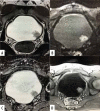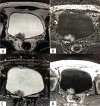Diagnostic performance of multiparametric MRI based Vesical Imaging-Reporting and Data System (VI-RADS) scoring in discriminating between non-muscle invasive and muscle invasive bladder cancer
- PMID: 37701172
- PMCID: PMC10493860
- DOI: 10.5114/pjr.2023.130807
Diagnostic performance of multiparametric MRI based Vesical Imaging-Reporting and Data System (VI-RADS) scoring in discriminating between non-muscle invasive and muscle invasive bladder cancer
Abstract
Purpose: The purpose of the present study was to assess the diagnostic accuracy of the Vesical Imaging-Reporting and Data System (VI-RADS) scoring system in predicting muscle infiltration of bladder cancer (BC) on a pre-operative multiparametric magnetic resonance imaging (mpMRI).
Methods: The prospective study enrolled patients with bladder lesions detected on a preliminary ultrasonography or cystoscopy. The patients underwent mpMRI on a 3T MRI scanner followed by surgery within 2 weeks. The tumours were assigned a VI-RADS score by 2 experienced abdominal radiologists. The VI-RADS score was compared with postoperative histopathological findings to confirm detrusor muscle infiltration. The diagnostic performance of VI-RADS for predicting muscle invasion was assessed by calculating sensitivity, specificity, positive predictive value (PPV), negative predictive value (NPV) and accuracy.
Results: A total of 60 patients were included in the study with a male: female ratio of 4.4 : 1. Transurethral resection of bladder tumour (TURBT) was performed in 47 (78.4%) and radical cystectomy in 13 (21.6%) patients. 19 (31.7%) had non-muscle invasive invasive BC (NMIBCa) and 41 (68.3%) had muscle invasive BC (MIBCa) on histopathology. There was a significant association between VI-RADS score and its components with muscle invasion (p < 0.05). A VI-RADS score of ≥ 3 had a sensitivity of 97.56% (95% CI: 0.87-0.99%), specificity of 73.68% (95% CI: 0.49-0.91), positive predictive value of 88.9% (95% CI: 0.79-0.94), negative predictive value of 93.33% (95% CI: 0.66-0.99), and diagnostic accuracy of 90% (95% CI: 0.80-0.96) for prediction of muscle invasion.
Conclusion: VI-RADS scoring system pre-operatively predicts the likelihood of muscle invasion in BC with a satisfactory diagnostic performance, and it should be incorporated in the diagnostic work-up of BC patients.
Keywords: Vesical Imaging-Reporting and Data System (VI-RADS); bladder cancer; multiparametric magnetic resonance imaging (mpMRI); muscle invasion; prediction.
© Pol J Radiol 2023.
Conflict of interest statement
The authors report no conflict of interest.
Figures





References
-
- Pecoraro M, Takeuchi M, Vargas HA, et al. . Overview of VI-RADS in bladder cancer. Am J Roentgenol 2020; 214: 1259-1268. - PubMed
-
- Mishra V, Balasubramaniam G. Urinary bladder cancer and its associated factors–an epidemiological overview. Indian J Med Sci 2021; 73: 239-248.
-
- Brausi M, Witjes JA, Lamm D, et al. . A review of current guidelines and best practice recommendations for the management of nonmuscle invasive bladder cancer by the International Bladder Cancer Group. J Urol 2011; 186: 2158-2167. - PubMed
-
- Witjes JA, Bruins HM, Cathomas R, et al. . European Association of Urology guidelines on muscle-invasive and metastatic bladder cancer: summary of the 2020 guidelines. Eur Urol 2021; 79: 82-104. - PubMed
LinkOut - more resources
Full Text Sources
